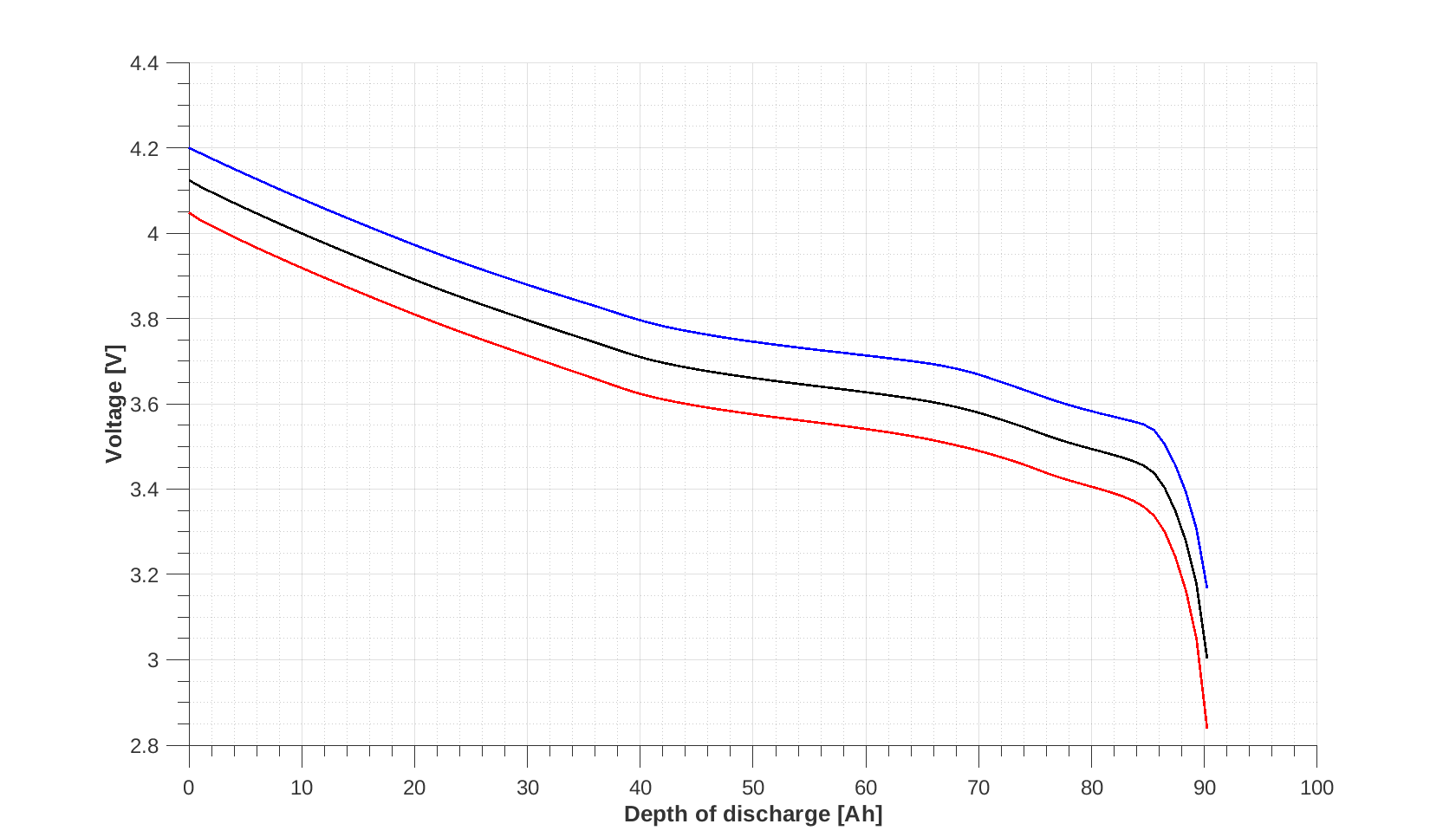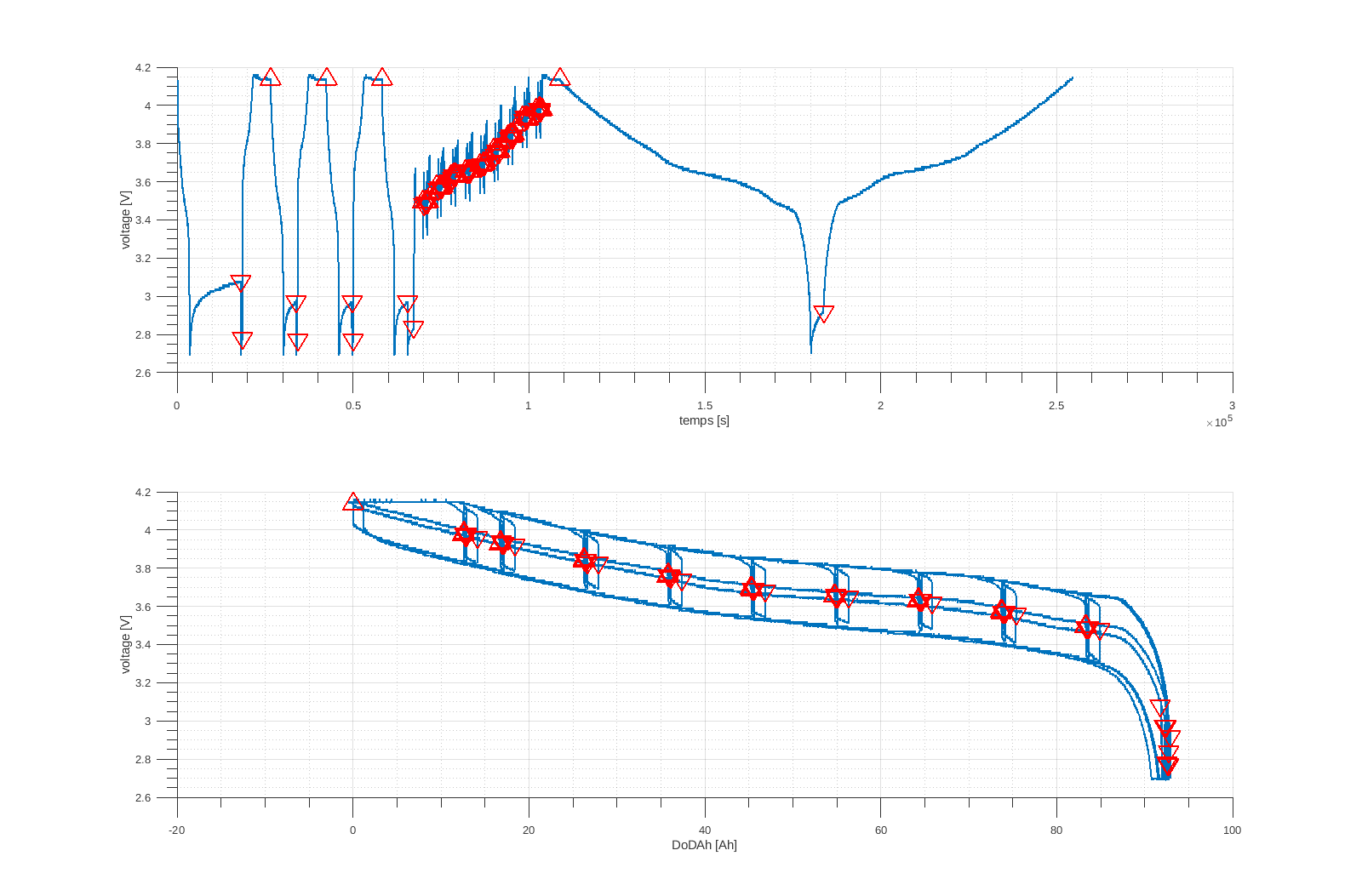Outline
Pseudo-OCV
Pseudo-OCV definition
Open circuit voltage (OCV) is the difference of electrical potentials between positive and negative electrodes of a cell when disconnected from any circuit. In the energy storage field, it is common to use the relation between open circuit voltage and state of charge to characterize a battery cell technology. Open circuit voltage can be measured by two experimental techniques and is named accordingly pseudo-open circuit voltage or open circuit voltage by points.
The pseudo-open circuit voltage measurement consist in applying a very low current in charge and discharge to the cell. As the current polarization is assumed to be negligeable, the voltage measured can be considered as a pseudo-open circuit voltage.
Analysis preparation
DATTES is called as follows : [result]=dattes(XML_file,'action','configuration_file').
Before any analysis, it is then necessary to create the XML and configuration files.
The section Import cycler files to analysis explains how to create the XML file.
The section Create a configuration filepage/documentation/create_configuration explains how to create a configuration file.
Anomaly detection
Pseudo-open circuit voltage test may be affected by noisy voltage measurements.
To check if an pseudo-open circuit test have run normally the action ‘GP’ should be used : [result] = dattes(XMLfile,'GP');

Pseudo-OCV analysis
To analyze the resistance, the action ‘P’ should be used :
[result] = dattes(XML_file,'Pvs');
The output are :
| Output structure | Field | Array | Unit | Description |
|---|---|---|---|---|
| result | pseudo_ocv | pOCV |
V | Voltage during the pseudo ocv test |
| result | pseudo_ocv | pDoD |
Ah | Depth of discharge during the pseudo ocv test |
| result | pseudo_ocv | pPol |
V | Voltage polarization during the pseudo ocv test |
| result | pseudo_ocv | pEff |
% | Efficiency during the pseudo ocv test |
| result | pseudo_ocv | UCi |
V | Charge voltage during the pseudo ocv test |
| result | pseudo_ocv | UDi |
V | Discharge voltage during the pseudo ocv test |
| result | pseudo_ocv | Regime |
- | Current rate during the pseudo ocv test |
Result vizualization
To visualize the pseudo ocv, the action ‘GP’ should be used :
[result] = dattes(XML_file,'GP');
The graph should look like

Methodology and Hypothesis
Method
The pOCV, pPol and pEff are calculated as combination of the voltage profiles during charge and discharge :
pOCV = cellfun(@(x,y) (x+y)/2,UCi,UDi,'uniformoutput',false);
pPol = cellfun(@(x,y) (x-y),UCi,UDi,'uniformoutput',false);
pEff = cellfun(@(x,y) (y./x),UCi,UDi,'uniformoutput',false);
with UCi and UDi which are respectively the linear interpolation of the voltage during charge and discharge :
UCi = cellfun(@(x,y) interp1(x,y,pDoD),DoDAhCs,UCs,'uniformoutput',false);
UDi = cellfun(@(x,y) interp1(x,y,pDoD),DoDAhDs,UDs,'uniformoutput',false);
This linear interpolation is made over pDoD vector which contains the coordinates of the query points. It is defined by the user in the configuration file :
pDoD = (0:config.dQOCV:config.Capa)';
Key parameters for the calculation
The key parameters for the calculation of the pseudo OCV are the quantities that make it possible to define what a pseudo-OCV phase is.
This definition is made in the configurator function thanks to the following parameters :
- config.pOCVpC,
- config.pOCVpD,
- config.dQOCV,
- config.Capa.
Assumptions and possible simplifications
No major assumptions or simplifications have been made
Contribute to pseudo ocv analysis
A list of open issues related to pseudo ocv calculation and visualization may be available here.
OCV by points
OCV by points definition
Open circuit voltage (OCV) is the difference of electrical potentials between positive and negative electrodes of a cell when disconnected from any circuit. In the energy storage field, it is common to use the relation between open circuit voltage and state of charge to characterize a battery cell technology. Open circuit voltage can be measured by two experimental techniques and is named accordingly pseudo-open circuit voltage or open circuit voltage by points.
The open circuit voltage by points measurement consist in applying a serie of current pulse used for setting a specific state of charge point which are followed by a rest. After few hours of rest, the voltage is measured. The interpolation of the different voltage measurement point make a curve which is known as open circuit voltage by points.
Preparation
DATTES is called as follows : [result]=dattes(XML_file,'action','configuration_file').
Before any analysis, it is then necessary to create the XML and configuration files.
The section Import cycler files to analysis explains how to create the XML file.
The section Create a configuration filepage/documentation/create_configuration explains how to create a configuration file.
Anomaly
Open circuit voltage by point test may be affected by noisy voltage measurements.
To check if an open circuit voltage by point test have run normally the action ‘GO’ should be used : [result] = dattes(XMLfile,'GO');

Analysis
To analyze the open circuit voltage by point, the action ‘O’ should be used :
[result] = dattes(XML_file,'Ovs');
The output are :
| Output structure | Field | Array | Unit | Description |
|---|---|---|---|---|
| result | ocv_points | ocv |
V | Open circuit voltage by points |
| result | ocv_points | dod |
Ah | Depth of discharge |
| result | ocv_points | time |
s | Time of open circuit voltage measurement |
| result | ocv_points | sign |
+/- | Sign of the current |
Visualization
To visualize the ocv by points, the action ‘GO’ should be used :
[result] = dattes(XML_file,'GO');
The graph should look like

Methodology
Method
All the array from result.ocv_points are determined thanks to function extract_phase :
phasesOCV = phases(config.pOCVr);
for ind = 1:length(phasesOCV)
[tp,Up,DoDAhp] = extract_phase(phasesOCV(ind),t,U,DoDAh);
tOCVp(ind) = tp(end);
OCVp(ind) = Up(end);
DoDp(ind) = DoDAhp(end);
Ipsign(ind) = sign(phasesAvant(ind).Iavg);
end
Key parameters for the calculation
The key parameter for the calculation of the OCV by point is pOCVr as it is the quantity that make possible to define what an OCV by point phase is.
Assumptions and possible simplifications
No major assumptions or simplifications have been made
Contribute
A list of open issues related to ocv by points calculation and visualization may be available here.